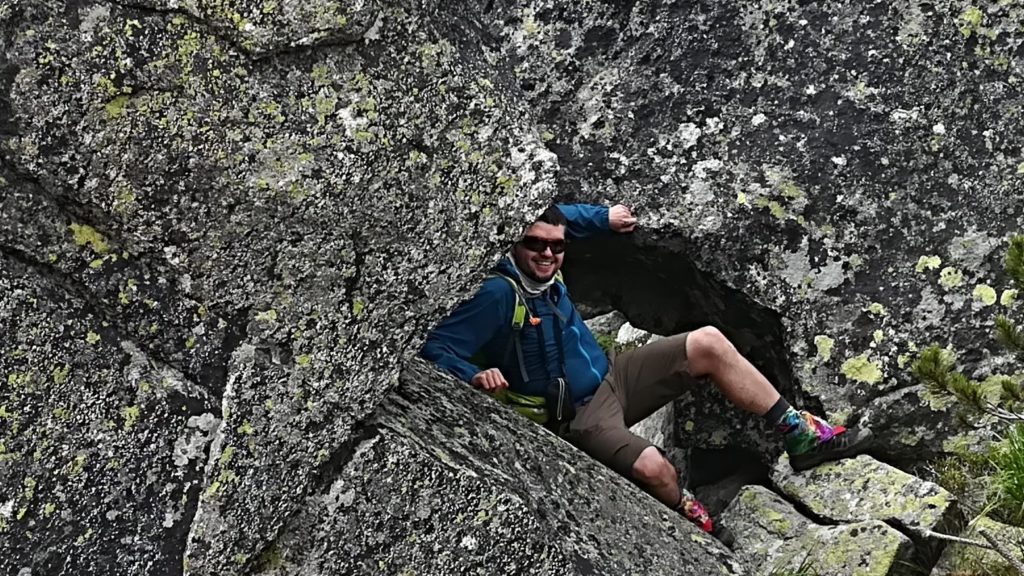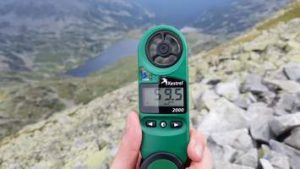This is just a simple list of the gear I’m currently using for day hikes in the summer and in a few cases alternatives I’m recommending. For every item I’ve included the pictures from the regional Amazon sites where I could find the exact item or something very similar, so you can see how it looks like and what the price is.
Backpack
What I use the most
My latest acquisition, the Ultimate Direction 35l Fastpack, review coming soon!
What else I use and recommend
I’ve used the Deuter Trans Alpine 30 daily in the past 5+ years and it’s holding up great. If you’re looking for an indestructible and very comfortable classical daypack, this is a great choice.
On some occasions, I’m using the Lowe Alpine Lightflite 25 backpack. It’s very lightweight but still has a good number of features, comes in handy when you need to pack it inside a bigger backpack, and before getting a proper running vest it was my running and racing backpack as well.
Hydration bladder
I’ve got great use out of my 3 liter Deuter Streamer, which failed on me this year in Norway, at the beginning of the 28 km (17.5 mile) Trolltunga hike. I replaced it with a very similar Source Widepac, which still awaits testing. For shorter hikes and running I bring the basic 1 or 2 liter bladders from Decathlon.
Clothing
Underwear
Yes, I know, it may be a little bit funny to talk about this, but when you’re working hard up the mountain, the last thing you want is your underwear to soak up the moisture and cause chafing. I prefer the Rab Merino Plus 120 Boxers.
Socks
Everybody who knows me knows that I love socks, thus naturally I have tried and tested a lot of hiking socks as well. And I feel that their importance in hiking is underrated, since using proper hiking socks I practically have no blisters. Currently, the Bridgedale Men’s Cool Fusion Trail Head Socks and Bridgedale Woolfusion Trail Men’s Socks are my favorites, depending on weather conditions.
Boots
Probably the most important piece of hiking clothing. I prefer boots with flexible soles (the rigid ones give me all kinds of problems, starting with heel blisters and ending with IT band knee pain). I like the aggressive sole of the Salomon Ultra 3 Mid GTX and it is the boot choice for both of us.
Hiking in trail running shoes is getting more and more popular, and depending on terrain and planned speed, sometimes I use my Salomon Speedcross 3.
Pants
I’m a shorts kind of guy, so when possible I hike in shorts. I have a pair of Mountain Equipment Comici Shorts.
In transition seasons when it’s colder I like its bigger brother the Mountain Equipment Comici Pants.
Rain pants
Usually carried in my backpack, I put on the Montane Minimus Pants when it starts pouring down heavily.
Base layer
I usually just grab one of the many polyester T-shirts I have and put a long sleeve T-shirt in my backpack, like the Icebreaker Merino Long Sleeve Half Zip. When I get to higher altitudes or it gets chilly I just swap the two.
Windbreaker
The Arc’teryx Squamish Hoody is one of my favorite gears.
Rainshell
My heavy duty rain jacket is the Montane Further Faster Neo jacket with Polartec Neoshell membrane, which is supposedly the waterproof material with the best ventilation, which comes in handy for a “hot” guy like me 🙂
For emergency situations and racing, I carry the Montane Minimus Smock.
Insulation
For when the weather gets harsh at high altitudes, the Arc’teryx Nuclei Hoody is the best, packs down to nothing, weighs less than a mid-weight fleece, blocks the wind, thermoregulates perfectly. One of my favorite gears.
Buff
Everybody should bring a Buff when hiking. It weighs nothing, comes in a variety of colors and patterns and is multi-functional, I use my High UV Buff against the sun, the wind and the cold.
Hat
Now I know, that these sun protection hats which protect your neck are not the best looking to say the least, trust me, I’ve been made fun of virtually anybody who saw me in my Columbia UPF 50 Hat. But after a day-hike at high altitudes in the burning sun, when everybody but you will lick their wounds, you will thank me.
Gloves
Honestly, I’m still looking for the perfect summer gloves, which have maximum dexterity, are sticky enough to grip rocks (and you don’t drop your phone on the rocks with them like I did recently) and are preferably waterproof. So I have no recommendation here, other than don’t forget bringing gloves with you, especially when you go to high altitudes and / or use hiking poles. If you have any glove tips for me, feel free to share in the comments.
Gaiters
This year I got my first pair of Dirty Girl Gaiters (yes, that’s the name of the brand) and honestly, I don’t know how I lived without them for so long. They are lightweight, breathable and keep small rocks, twigs, dirt, and mud out of my boots, so I don’t have to stop every half an hour to empty it. As a bonus, they have all kinds of cool designs and they are surprisingly durable for their light weight.
For summer I’ve used an older model of Montane Gaiters before getting the girls 🙂
Sunscreen
I don’t usually carry the sunscreen with me all the time, just apply it at the beginning of the hike. You should really not skip this, even if you are the kind that “never gets sunburn”. For higher altitudes, I use the ones with SPF 50 and my summer tan goes away around November.
Trekking poles
I recently purchased my first pair of Z-type carbon fiber poles and I absolutely love them. I had my doubts about how well the lightweight Black Diamond Distance Carbon Z poles would do with my 90 kilos (200 lbs), but I had no issues whatsoever so far, hiking or running with them.
I still have my Black Diamond Trail Shock poles and they are still going strong, usually used by my girlfriend nowadays.
Headlamp
Actually, I should have started with this one because I truly believe it is the most important hiking gear to have. If it gets dark and you have no means of generating light until you get back to civilization – you are screwed big time. I have tried multiple headlamps from Petzl and Black Diamond and I was just not very happy with them. They tended to fail when I needed them most, last time on the top of the mountain in the winter! So now I use the Nitecore HC50 and I’m very happy with it so far. Since the mentioned event I always carry reserve batteries AND a reserve headlamp WITH reserve batteries.
For an emergency headlamp, I carry an old Petzl model which I don’t think is still in production, but a lot of people recommend the Petzl e+LITE as an emergency headlamp.
Navigation
Nowadays I use my Samsung Galaxy S7 smartphone together with my Fitbit Charge 2 to record the GPS track of the route. For longer hikes it doesn’t work perfectly unfortunately, parts of it get cut off, usually the beginning (probably because of a lack of memory of the Fitbit). In the past, I’ve used my Suunto Ambit 2R watch, but my smartphone is always with me with an offline GPS map downloaded to it. Of course, I have a printed map with me as well most of the time.
Safety
In other parts of the world, this may not be an issue, but I don’t leave without an ultrasonic dog repellent, especially when I plan to go in the vicinity of rural areas. It doesn’t work 100% of the time, but I prefer having one more safety precaution.
Hygiene
Again, this category may be very obvious to most. But believe it or not, at some point in my life I didn’t know of the existence of these basic products, so maybe it helps someone.
I always bring a small 75 ml (2.5 ounces) hand sanitizer gel with me. I just buy what’s available in the local hypermarket, usually Touch or Sanytol brands (Aptonia brand is also available at Decathlon).
And of course wet wipes for when you have to go (please don’t leave those out in the nature, most of them are not biodegradable). Probably the best bet is again the local store, but I still put here some links so you get an idea what I’m talking about.
Water filtration
Water found in nature is generally safe to drink in Transylvania and I usually try to bring enough water with me for the entire day. But in the rare occasions, there won’t be any sure springs on the way and I’m not sure how long the hike will take, I may bring my Sawyer Mini with me.
Temperature and wind speed
By no means, you need to have one, but for the curious of you out there who want to know the EXACT temperature and wind speed, I recommend a Kestrel 2000.
First aid kit
| just got a basic first aid kit from Hervis (Kilimanjaro brand) with band-aids, patches, and some other stuff, and added things to it along the way, like anti-inflammatory and anti-allergic tablets. You can find more sophisticated ones from established outdoor brands.
What I DON'T bring
For day hikes I see absolutely no reason to bring a knife and I don’t have the slightest idea why so many people are obsessed with knives in the context of hiking. If you do, please explain it to me in the comments.
I rarely bring a stove for hiking, and for shorter ones (less than a week) I never do. I can get along with cold food that long and I prefer to save the weight and cooking time. Oh, and I don’t need coffee to live.



Pingback: Gifts for hikers: how to find the right one? - Transylvanian Hiker